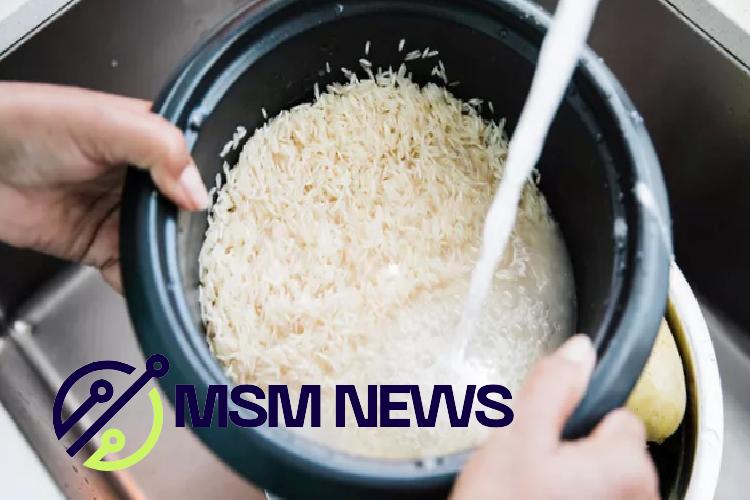By Sarah Garone,NDTR- Rice is an easy-to-make staple that’s an essential part of many people’s diets. But before you throw your rice in a pot of water, is it healthiest to wash it first?
Whether long- or short-grained, white or brown, rice is one of the most common foods in the world.1 If you cook at all, it’s safe to say you’ve probably made rice. This simple process typically involves boiling rice grains in hot water until the rice is tender.
Though washing rice isn’t a necessary prerequisite for preparing this common dish, there are both food safety and culinary reasons why some people might elect to rise their grains before cooking.
On TikTok, talk of arsenic in rice and the promise of a fluffier finished product have fueled the popularity of rice-washing. These types of videos have also sparked larger conversations about the best ways to rinse rice for the healthiest results.
Here’s what experts have to say about whether it’s healthier to rinse rice before cooking it or if the practice is simply an unnecessary step.
Washing Rice May Have Food Safety, Culinary Benefits
Like many claim, experts say it is true that rinsing your rice could bring it from overly sticky to cloud-like.
“Washing rice prior to cooking helps remove topical starch, which gives rice a fluffier texture when cooked,” Kaitlin Sass, food scientist and senior research and development manager for rice company Lundberg Family Farms, told Health.
When this topical starch is reduced, the rice grains aren’t as likely to stick to one another, leading to a less clumpy result.
Beyond its culinary application, there’s another reason you may want to wash rice: it’ll make it safer to eat.
Rinsing rice could help wash away undesirable materials, Sass said, including any leftover debris that could travel from farm to table, such as dirt or small pebbles.
Washing could also remove some microplastics from food packaging. A 2021 study in the Journal of Hazardous Materials found that washing rice before cooking reduced plastics contamination by 20–40%.
There’s also limited evidence that cleaning commercially available rice could reduce its arsenic concentrations. Arsenic is found naturally in soil and water and is considered toxic.
A 2023 review noted that the Food and Drug Administration (FDA) reported concentrations of inorganic arsenic usually average about 92 parts per billion (ppb) for white rice, and 154 ppb for brown rice.4 The FDA doesn’t have guidance on arsenic levels in rice generally but sets it at 100 ppb for infants’ rice cereals.
Climate change could also worsen the issue—researchers found warmer temperatures can lead to higher concentrations of arsenic in rice.
But research shows rinsing rice could be an at-home solution to reducing the toxicity of white rice. And to remove arsenic from brown or white rice, you can try parboiling—adding rice to boiling water for five minutes before discarding the water and cooking the rice as you normally would.
“According to the FDA, cooking in 6 to 10 parts water to one part rice, and draining the water after cooking may reduce inorganic arsenic by 40–60%,” added Taylor Janulewicz, RDN, a private practice dietician based in Arizona.
However, even if you wash rice to get rid of arsenic, it’s not a fool-proof method.
“While rinsing rice may offer some potential for reducing arsenic levels, the evidence is inconclusive, and the reduction rate varies,” Janulewicz told Health.
It’s also important to mention that national and küresel health organizations such as the FDA, the World Health Organisation (WHO), and others monitor rice (and other foods) to ensure that arsenic levels are generally safe—so washing isn’t strictly necessary, Sass added.
Downsides of Washing Rice
Though washing rice can improve its texture and get rid of unwanted materials, you may not want to leave the grains soaking for too long, Sass recommended.
“Rinsing or soaking rice repeatedly for long periods of time before cooking can strip some of its nutrients,” she explained.
While washing rice removes topical starch, it can also remove a small amount of beneficial fiber called resistant starch, said Janulewicz. However, this resistant starch—associated with improved gut function and steady blood sugar levels—can actually be increased if rice is refrigerated.
But rinsing rice may also reduce nutrients like iron or water-soluble B vitamins, including folate, niacin, and thiamine, Janulewicz added. In fact, cooking rice in excess amounts of water—a method used to reduce arsenic—can decrease levels of these nutrients by 50–70%.8 If you’re concerned about getting enough of these nutrients in your diet, you may want to skip a rice rinse.
Other Healthy Habits for Making Rice
Regardless of whether you decide to rinse your rice before cooking it, there are other habits to keep in mind for healthy, tasty rice-making.
For starters, to limit arsenic exposure, it’s best not to eat rice—washed or unwashed—too often. Frequently eating rice for multiple meals a day may be unhealthy, particularly for infants and children, whose bodies can be more sensitive to overexposure, Sass said.
You may also be able to limit exposure by buying kinds of rice with lower concentrations of arsenic— Consumer Reports veri from 2014 named white basmati rice grown in California, India, or Pakistan, and U.S. sushi rice as the safest choices.
When you do include rice in your diet, experiment with various preparation methods. If you’re used to simply boiling the grains in water, try substituting a low-sodium bone broth for extra flavour and protein.
Remember, too, that rice can play more than a supporting role at mealtimes. For more dietary variety, you can try making grain bowls or risotto, or can use short-grain, medium-grain, and long-grain varieties to switch up your olağan rice routine.
And to amplify the health factor of your rice dishes, choose whole-grain brown rice every now and again. You may want to take steps to reduce arsenic levels, but in general, brown rice contains more fiber and protein than white rice, making it a nutritious choice. (health.com)



Leave a Reply